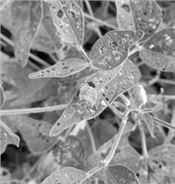|
Wrapping Up Insect Management For The Year: Pod And Seed Feeding In Soybean
DR. NICK SEITER
URBANA, ILL.
In terms of insect management, we are pretty close to the finish line for corn and soybean in Illinois. However, there has been a late-season onset of bean leaf beetles in soybean in some parts of the state. Pod and seed feeders are one of the last insect pest threats we face in soybean, so let’s review our management guidelines as we wrap the season up.
Bean leaf beetles and pod scarring
We have seen some fairly large bean leaf beetle populations in central and northern Illinois over the last couple of weeks. While their foliar feeding is quite noticeable in many fields, it is unlikely to pose a risk to yield at this point, especially as we move well into R6 in most of our fields. (Our economic threshold after bloom is 20 percent defoliation.) In addition to foliar feeding, bean leaf beetles will feed on the lining of the soybean pod, which can allow the entry of pathogens into the pod and reduce seed quality. My colleagues at Purdue University just posted a detailed analysis of this damage and the management decision-making process; read their article here, and check out their decision table at the end of the article: https://extension.entm.purdue.edu/newsletters/pestandcrop/article/bean-leaf-beetle-pod-feeding-on-late-maturing-soybean/. Depending on the stage of the pods and the number of beetles in the field, an application might be needed at anywhere from 5-12 percent of pods damaged. You should use the low end of that range if pods are still green and beetle numbers are high (5-7 beetles per sweep if using a sweep net), and move to the high end of the range as pods mature and beetle numbers decline (again, see the decision table for more details). As the foliage begins to yellow, bean leaf beetles will often move on; avoid “revenge sprays” for pod scarring if the beetles have already left your field. Bear in mind, 5-12 percent of pods scarred is quite a few, and is well above what I have been seeing in the fields I have walked.
Stink bugs and seed feeding
Stink bugs actually feed on the seed itself, rather than just the pod. Because of this, they are more likely to reduce yield in addition to quality, and our thresholds are lower as a consequence: 9 stink bugs per 25 sweeps when sampling with a sweep net, or 1 per row foot if using a shake sheet or visual sampling. Fortunately, our stink bug numbers in most of Illinois this year appear to be lower than they have been for the last couple of years, but don’t take my word for it – scout your fields to verify your local population, and make your decision accordingly.
Pod and seed-feeding insects can be a threat to yield and quality. However, just because we are seeing the insects in the area does not mean we need a late-season spray. Before you put a plane in the air, scout and use the economic thresholds to verify whether that application will provide a positive return and not be a wasted expense. ∆
DR. NICK SEITER: Research Assistant Professor, Field Crop Entomologist, University of Illinois

An adult bean leaf beetle feeds on soybean foliage.

Bean leaf beetle feeding “scars” pods, which can allow pathogens to enter as the pod matures.

A brown marmorated stink bug adult rests on soybean foliage
|
|